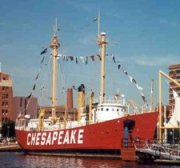

As soon as mankind began shipping cargo across the water 24 hours a day, the need for nighttime navigational aids arose. While the technology has been in place to build lights of some sort on land for thousands of years, these were often of limited use because they were distant from the actual shoals or hazards they marked. The use of lighted boats or ships was one solution to this problem. Lighted ships could often be moored in shallow water or where conditions prevented the erection of free-standing structures. They could be anchored many miles off shore and moved as the need arose. While the 5th Auditor of the Treasury, Stephen Pleasonton, is noted for his lack of vision in many aspects of his administration of the early U.S. lighthouse system, he did embrace the concept of the lightship and the first U.S. lightship was established at Willougby Spit, VA in 1820.
For the first century and a half of their use in the United States, lightships had no specific design. Generally a mid-sized schooner was outfitted with a light or lights which could be raised up the mast and the ship was either anchored or moored at its station. These ships had been built for transport and were generally poor light platforms. Not having been designed to be anchored for months at a time in exposed locations, they did not ride out storms well and tended to roll and pitch terribly. Furthermore, should they pull free during a storm, conditions made it difficult to quickly raise any sail and maneuver or maintain position. Because of their exposed positions, often marking heavily shipped channels, collisions were common. Early lightships carried little in the way of spare equipment and if one did loose an anchor or become damaged, it was generally necessary to leave station unattended while replacement parts or repairs were obtained. It wasn't until 1837 that a relief vessel was purchased for the Chesapeake Bay region and at the time of the second Congressional audit in 1851, there still existed only one such relief vessel. Finally, during Pleasonton's administration lightships suffered some of the same mismanagement of their lighthouse counterparts. Some were in good shape and well run. Others were rotting or leaky and, in some cases, the masters contracted out watch duties at low wages while they ran their farms or businesses on shore. This all changed after the reorganization of the lighthouse system in 1852.
Under the new lighthouse board, the lighting apparatus were upgraded, the ships were outfitted with spare equipment, and put under systematic management. Since lightships required a comparatively large crew and were expensive to maintain, the new Board sought to replace them with lighthouses whenever feasible. The new screwpile lighthouse technology was embraced and Chesapeake Bay lightships were replaced by free-standing structures wherever and whenever possible. The Civil War also disrupted the operation of Bay lighships. Several were captured by Confederate raiding parties, stripped, and scuttled. By the end of the century, most U.S. lightship stations were in open water where it was not feasible to build a lighthouse, even with the most modern technology.
In 1867 "LV" numbers were assigned to each vessel in an effort to better identify and keep track of them. The numbering started from the northern U.S. heading south and only covered those lightships in service at the time. (Decommissioned ships were not included.) However, as new ships were commissioned, they were assigned the next sequential number. So, the numbering system took on a chronological order for ships built after 1867. When the Lighthouse Service was merged into the U.S. Coast Guard in 1939, a newer set of "WAL" numbers were assigned.
Towards the end of the 19th century the lightship, at last, came to be recognized as a special purpose vessel which necessitated special design features. In 1886 the Board recommended replacing wooden ships with iron hulled ones as they wore out. As the decades passed engines were installed, stabilizing bilge keels added, living quarters improved, and specialized anchor and mooring systems developed. The lights were electrified which eliminated the need to raise and lower the lamps. Eventually as the 20th century progressed, the technology was such that the remaining lightships could be replaced by off-shore buoys and, in some off-shore cases, large "Texas tower" style lighthouses such as the one off the mouth of the Chesapeake Bay. The end of the era came in 1983 when the last U.S. lightship, Nantucket Shoals, was decommissioned.